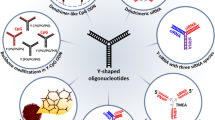Abstract
Specific inhibition of mammalian genes is possible through the use of antisense oligonucleotides (AS ODNs) or ribozymes. These strategies have led to a better understanding of several cellular and molecular mechanisms, among which cancer development. Recently, these strategies have been applied also for therapeutical purposes in diseases such as AIDS and cancer. In some of these therapeutical trials the antisense strategy is combined with gene transfer technology: the AS ODN or the ribozyme are expressed within the cell by the use of adenoviral or retroviral vectors. However, many difficulties have still to be overcome before ODNs and ribozymes can be used routinely in the clinic.
Similar content being viewed by others
References
Scanlon KJ, Ohta Y, Ishida H, Kjima H, Ohkawa T, Kaminski A et al. Oligonucleotide-mediated modulation of mammalian gene expression. FASEB J 1995;9:1288–96.
Stein CA. Antitumor effects of antisense phosphorothioate c-myc oligodeoxynucleotides: a question of mechanism. J Natl Cancer Inst 1996;88:391–3.
McShan WM, Rossen RD, Laughter AH, Trial J, Kessler DJ, Zendegui JG et al. Inhibition of transcription of HIV-1 in infected human cells by oligodeoxynucleotides designed to form DNA triple helices. J Biol Chem 1992;267:5712–21.
Kashani-Sabet M, Scanlon K. Application of ribozymes to cancer gene therapy. Cancer Gene Ther 1995;2:213–23.
Quattrone A, Di Pasquale G, Capaccioli S. Enhancing anti-sense oligonucleotide intracellular levels by means of cationic lipids as vectors. Biochemica 1995;1:25–9.
Crooke ST. Progress in antisense therapeutics. Hematol Pathol 1995;9:59–72.
Chiang MY, Chan H, Zounes MA, Freier SM, Lima WF, Bennett CF. Antisense oligonucleotides inhibit ICAM-1 expression by two distinct mechanisms. J Biol Chem 1991;266:18162.
Kuramoto E, Yano O, Kimura Y, Baba M, Makino T, Yamamoto S, Yamamoto T, Kataoka T, Tokunaga T. Oligonucleotide sequences required for natural killer cell activation. Jpn J Cancer Res 1992;83:1128.
Psietsky DS, Reich CF. Stimulation of murine lymphocyte proliferation by a phosphorothioate oligonucleotide with anti-sense activity for herpes simplex virus. Life Sciences 1993;3:391.
Slavkin HC. Antisense oligonucleotides: an experimental strategy to advance a casual analysis of development. Int J Dev Biol 1995;39:123–6.
Lefebvre-d′Hellencourt C, Diaw L, Guenounou M. Immunomodulation by cytokine antisense oligonucleotides. Eur Cytokine Netw 1995;6:7–19.
Pan Y-X, Cheng J, Xu J, Rossi G, Jacobson E, Ryan-Moro J et al. Cloning and functional characterization through antisense mapping of k3-related opioid receptor. Mol Pharmacol 1995;47:1180–8.
Sun LQ, Pyati J, Smythe J, Wang L, Macpherson J, Gerlach W et al. Resistance to human immunodeficiency virus type 1 infection conferred by transduction of human peripheral blood lymphocytes with ribozyme, antisense, or polymeric transactivation response element constructs. Proc Natl Acad Sci USA. 1995;92:7272–6.
Tan TMC, Ting RCY. In vitro and in vivo inhibition of human papillomavirus type 16 E6 and E7 genes. Cancer Res 1994;15:4599–605.
Neurath MF, Pettersson S, Meyer zum Buchenfelde K-H, Strober W. Local administration of antisense phosphorothioate oligo-nucleotides to the p65 subunit of NF-kB abrogates established experimental colitis in mice. Nature Med 1996;2:998–1004.
Leonetti C, D'Agnano I, Lozupone F, Valentini A, Geiser T, Zon G et al. Antitumor effect of c-myc antisense phosphorothioate oligonucleotides on human melanoma cells in vitro and in mice. J Natl Cancer Inst 1996;88:419–29.
Monia BP, Johnston JF, Geiger T, Muller M, Fabbro D. Antitumor activity of a phosphorothioate antisense oligodeoxynucleotide targeted against C-raf kinase. Nature Med 1996;2:668–75.
Kiehntopf M, Brach MA, Licht T, Petschauer S, Karawajew L, Kirschning C et al. Ribozyme-mediated cleavage of the MDR-1 transcript restores chemosensitivity in previously resistant cancer cells. EMBO J 1994;13:4645–52.
Bishop MR, Bayever E, Iversen PL, Sharp G, Spinolo J, Zon G. et al. Phase I trial of systemic administration of OL(1)p53 oligonucleotide in refractory acute myelogenous leukemia and advanced myelodysplastic syndrome. Blood 1993;82 Suppl 1:443a.
Roth JA. Gene replacement strategies for cancer. Israel J Med Sci 1996;32:89–94.
Author information
Authors and Affiliations
Rights and permissions
About this article
Cite this article
Calogero, A., Hospers, G.A. & Mulder, N.H. Synthetic oligonucleotides: Useful molecules? A review.. Pharm World Sci 19, 264–268 (1997). https://doi.org/10.1023/A:1008699515124
Issue Date:
DOI: https://doi.org/10.1023/A:1008699515124




